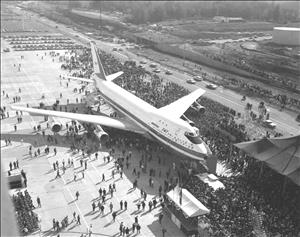On September 30, 1968, Boeing rolls out the first 747 "Jumbo Jet" in Everett, Washington. The aircraft, originally designed to haul both cargo and passengers for Pan Am Airways, was more than twice the size of the Boeing 707. In order to assemble the flying behemoth, Boeing built the world's largest structure by volume, enclosing 291 million cubic feet, at Paine Field in Everett.
Early Planning
Plans for the Boeing 747 were developed in the early 1960s, after Juan Trippe (1899-1981), president of Pan American World Airways, expressed interest in a plane that was larger than either the Boeing 707 or the Douglas DC-8, the two aircraft that had ushered in the Jet Age.
Jack Steiner (1917-2003), Boeing's vice-president of product development oversaw the 747 in its planning stages, and Boeing CEO Bill Allen (1900-1985) chose Mal Stamper (1925-2005) as general manger when the project went into full design. Joe Sutter (1921-2016) was named chief engineer.
In 1966, Pan Am signed a $550 million contract for 25 planes, deliverable by the end of 1969. By Boeing standards, this was a very short time frame to complete the project, especially since design was not yet complete, and the production plant had yet to be built. In effect, Boeing bet the company that the project would succeed.
A Big Jet Needs a Big Building
Boeing initially considered building the 747 outside of Washington state, but eventually settled on 780 acres of land near Everett. Located next to Paine Field, the property was hilly and heavily wooded. More than four million cubic yards of dirt had to be removed to make way for the world's largest building under a single roof.
Construction moved quickly, but barely fast enough to keep up with the schedule. Work began on the 747 mockup before the walls of the mockup building were complete. Workers on the assembly line had to wear heavy clothing during the winter, because the building was not yet been heated.
Original plans for the 747 included a double-deck design, but this concept was nixed due to concerns about emergency evacuations. Instead, the plane was given a wide-body design, the first in the world. The plane's distinctive hump behind the cockpit came about due to aerodynamic streamlining, but was used to house a passenger lounge at the suggestion of Juan Trippe.
More Orders Come In
While work continued on the 747, Boeing gathered up orders from other airlines. Most airline executive visited the production plant while making their decision, and came away in awe. When Pat Patterson (1899-1980), president of United Airlines, entered the mockup building, the first words out of his mouth were, "Jesus Christ!" (Serling, Legend and Legacy).
By the time the 747 was ready for its unveiling, orders had been placed from 26 airlines for the new jet. Representatives from each of these airlines gathered with other invited guests -- as well as the press -- on September 30, 1968, for the plane's first public appearance.
The 747 Debuts
That morning, a replica of the B& W -- Boeing's first airplane -- flew over Paine Field, followed by a 707, a 727, and a 737. The crowd of attendees gathered in front of the massive hangar doors of the production plant. The doors opened slowly, and a tractor towed the 747 out into the bright sunlight.
Unlike previous Boeing airliners, which were painted canary yellow and brown, the 747 was painted white and red, with blue lettering. As the plane came into view, the audience gasped at its size and broke into thunderous applause. At 231 feet in length, with a 196-foot wingspan, the 747 was far larger than any plane most of them had seen before.
United States Secretary of Commerce C. R. Smith (1899-1990) was the principal speaker, and noted that the 747 "will provide a standard of comfort and convenience never equaled before." (The Seattle Times, September 30, 1968) He noted that over $1.5 billion worth of contracts had already been signed for the new plane, and that more were on the way.
Bill Allen noted that the 747 program was one of the largest nongovernmental projects in United States history. Boeing President T. A. Wilson (1921-1999) spoke next and introduced Governor Dan Evans (b. 1925), and Senators Warren Magnuson (1905-1989) and Henry M. Jackson (1912-1983). Finally, Mal Stamper thanked all of the Boeing employees who worked on the project, but noted that the plane still had to go through flight test and government certification.
The 747 was christened by 26 flight attendants, then called stewardesses, one each from the 26 airlines that had already placed orders. As they smashed their 26 bottles of champagne against the jumbo jet, a cheer rang out from the crowd.

